Homemade Sourdough Bagels – With Video
Sourdough bagels are chewy, crusty and properly dense. They have an extra deep flavor thanks to the sourdough starter in the recipe. This recipe take more than 12 hours to make, but the vast majority of the time is hands-off.

I’ve said it before, I think a good bagel should have a nicely dense and chewy texture with a toothsome crust. Forget the frozen hockey pucks from the grocery store, and the bagels from chain bakeries that are way too fluffy to be a real bagel.
Homemade bagels are not hard to make and they freeze beautifully. If you set aside a little time over a weekend, you can stock up the freezer for weeks to come.
This Sourdough Bagel recipe is a variation of my popular recipe for New York Style Bagels.
If you don’t already have one, I can show you how to make a sourdough starter and how to feed a sourdough starter.
Ingredients
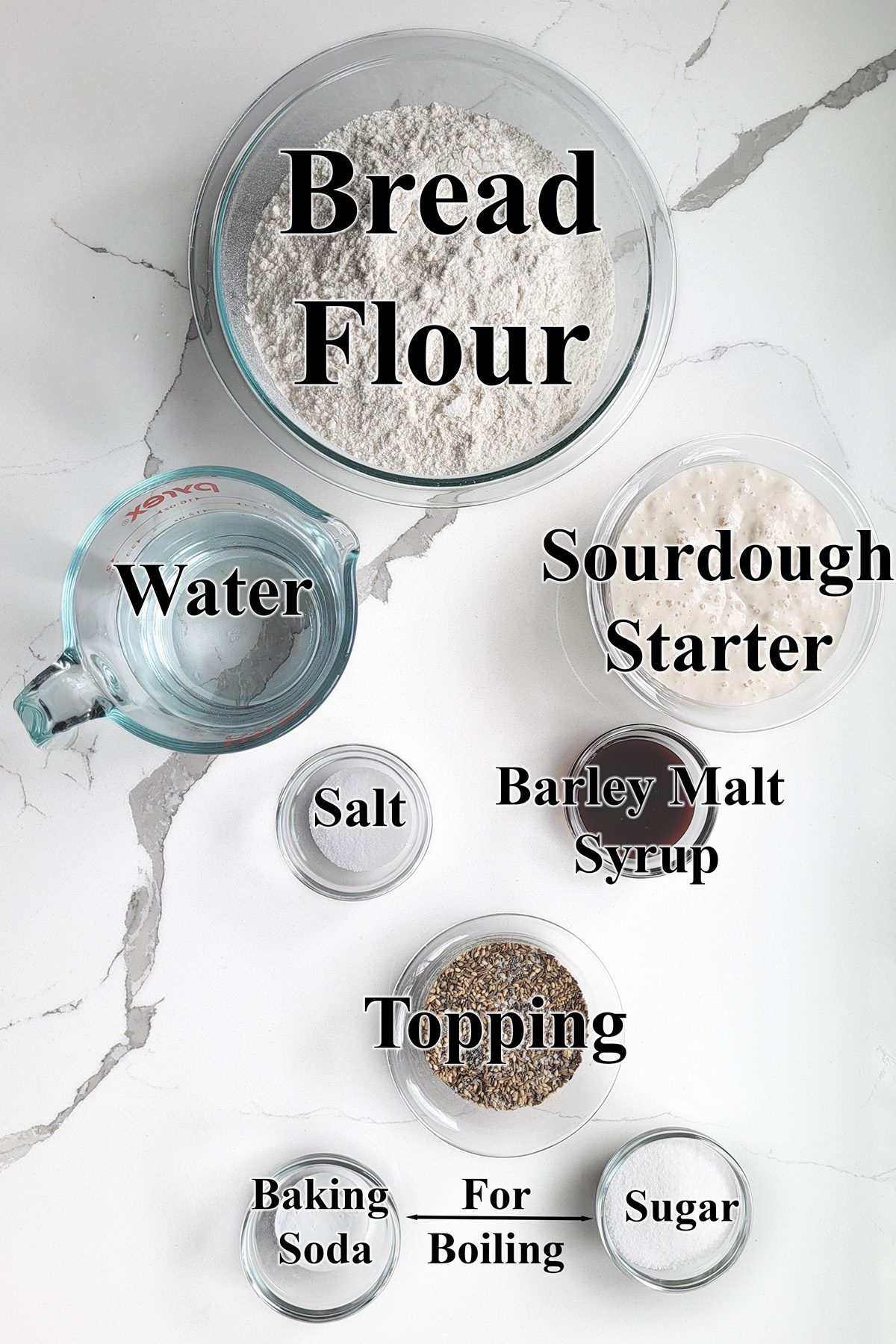
Ingredient Notes
- Bread Flour – Bagels should have a very chewy crumb from a strong gluten network in the dough. High protein bread flour develops plenty of gluten.
- Sourdough Starter – The recipe was developed using 100% hydration starter. You will need to adjust the liquid or flour in the recipe if you’re starter isn’t at 100% hydration. Your starter should be fed and active when you mix the bagel dough.
- Barley Malt Syrup – Adds a traditional slightly sweet note to the dough. You can substitute honey or a combination or honey and molasses for the barley malt syrup.
- Toppings – Leave the bagels plain or use your favorite seed for topping. You can mix seeds with salt to make your own “everything” bagel topping”. See the recipe card for details.
- Baking Soda & Sugar – For boiling the bagels. The boiling process creates the specific shiny and chewy bagel crust.
Process photos for making Sourdough Bagels
Here’s what the recipe process looks like at each stage. Refer to the recipe card below for measurements and exact instructions.
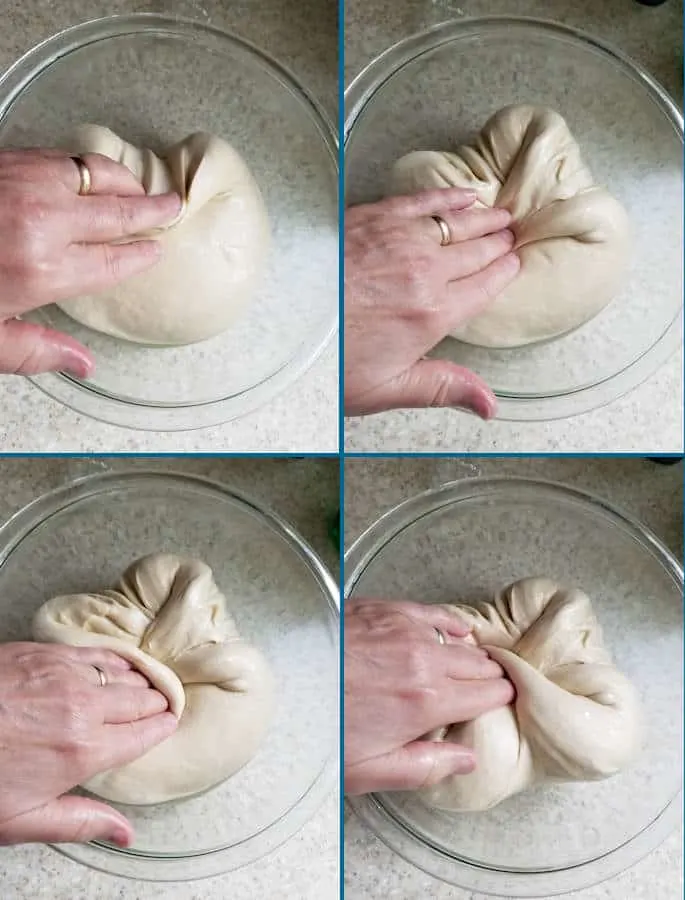
- As the dough ferments, it should be folded onto itself every hour or so to redistribute the yeast.
- Fold from each side into the middle, then flip the dough over.
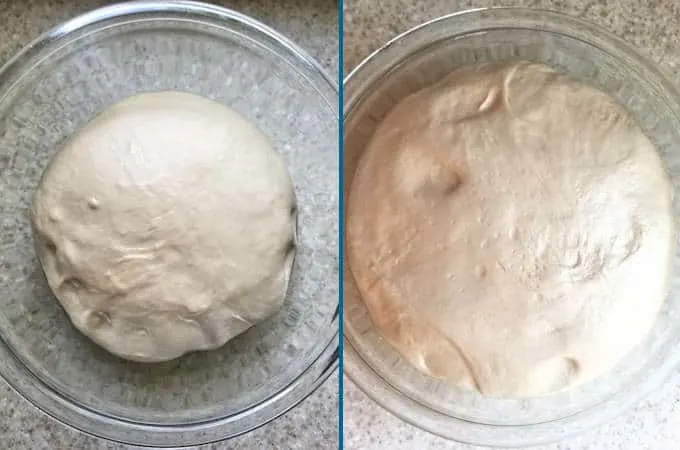
- After 30 minutes there’s not much activity in the dough (left).
- After 3 hours the dough should be active and nicely aerated (right).
- After fermentation it’s time to shape the bagels.
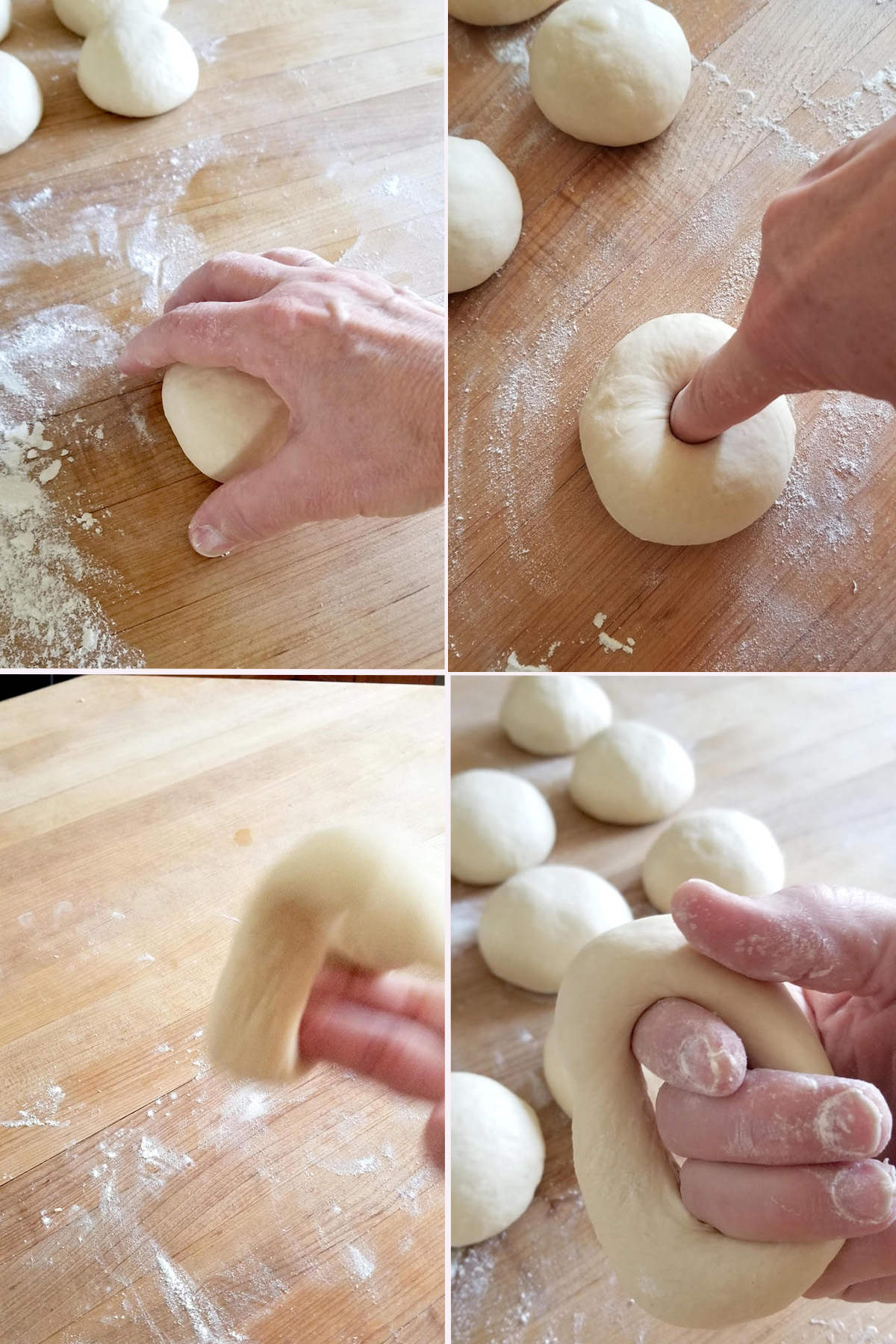
- Use a cupped hand to form the a piece of dough into a tight ball. Repeat with all the pieces of dough.
- Poke your finger all the way through the center of the ball to make a hole.
- Twirl the dough around your fingers to widen the center hole.
- Set the bagel onto the baking sheet and continue with the rest of the dough.
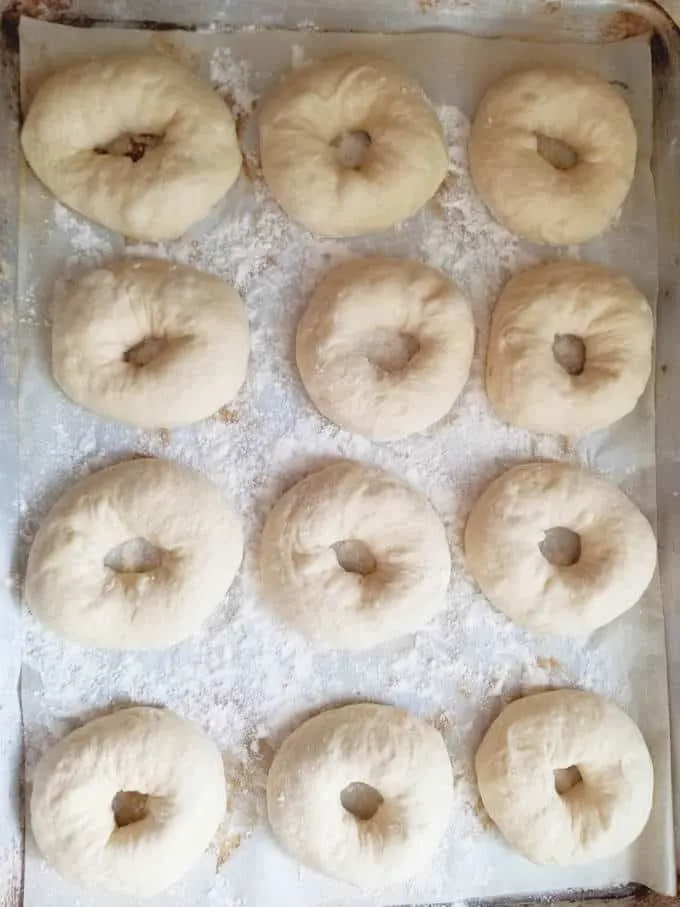
- Line the formed bagels onto a well-floured (or use cornmeal) sheet pan to prevent sticking.
- Cover the pan and place it in the refrigerator overnight.
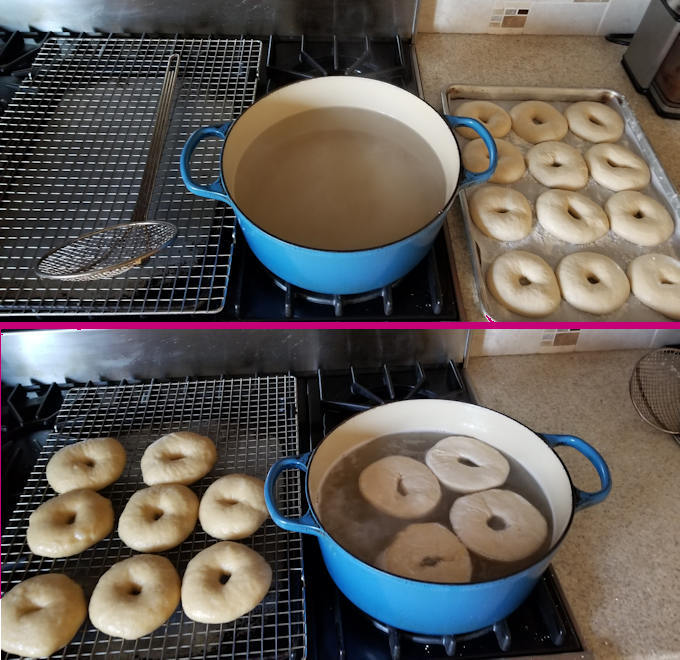
- Bring a pot of water with baking soda and sugar to a boil. Preheat the oven.
- Boil the bagels a few at a time, flipping them every thirty seconds. Boil each batch for 2 minutes.
- Transfer the bagels to a rack to drain while you finish boiling the rest of the bagels.
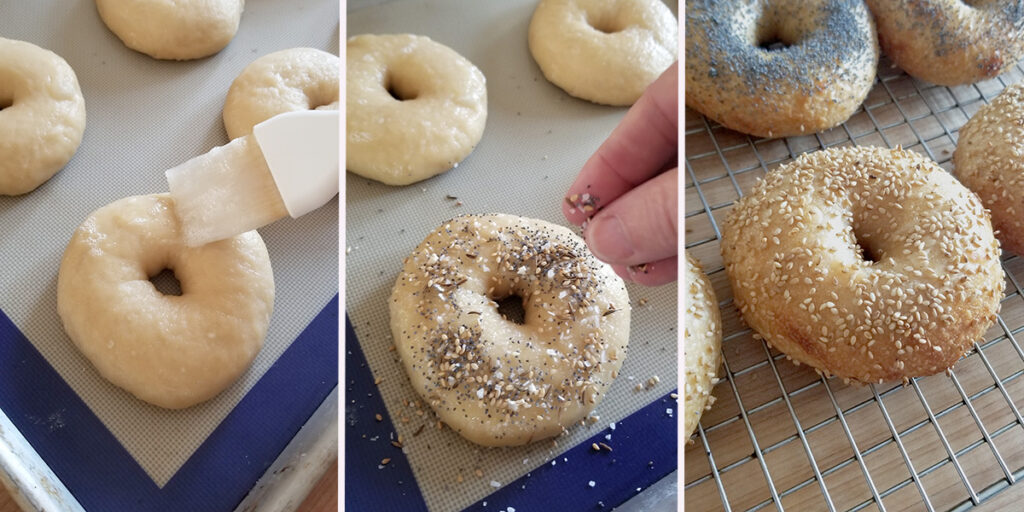
- Brush the boiled bagels with egg white.
- Sprinkle seeds or bagel topping if desired.
- Bake until the bagels are golden brown.
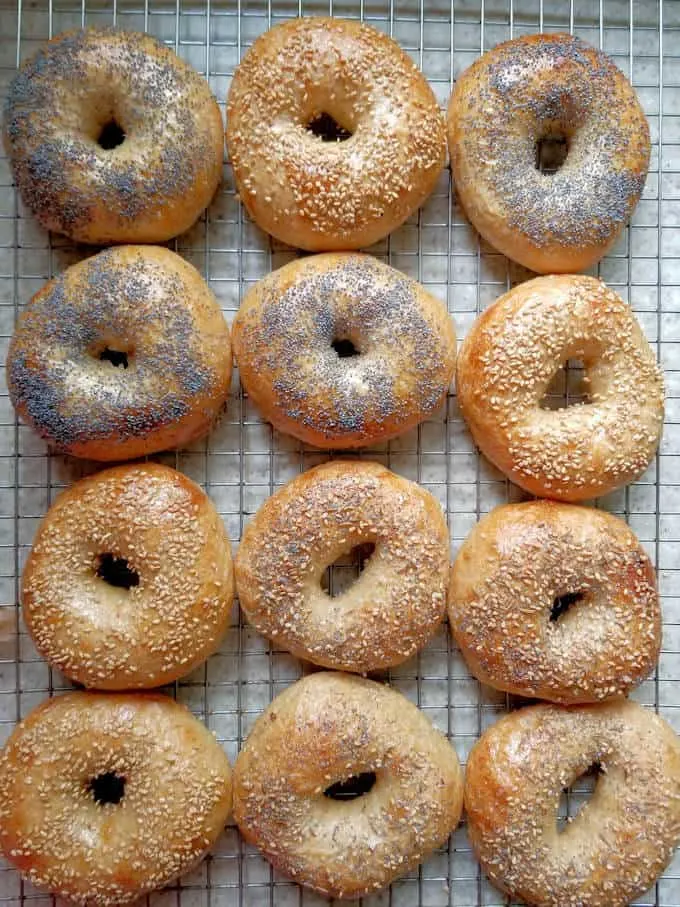
Recipe Tips
- Make sure your starter is very active and lively. I get the best results when I do two feedings in the days before making this dough. I keep several starters and use the Small Starter for this recipe because it requires two feedings before baking with it.
- To get a good bagel shape that will rise properly, you must create a tight ball of dough before making the ring. Use a cupped hand and surface friction to roll the dough into a ball. You can see how it’s done in the recipe video.
- Place the shaped bagels on sheet pan which has been sprinkled liberally with cornmeal or flour. If the bagels stick to the pan you will loose volume when transferring them to the water. I find cornmeal works best, but flour will work too.
- In the morning, take the bagels out of the fridge and leave them out until the dough comes to room temp.
- Don’t start boiling the bagels until the oven is preheated. They should go into the oven within minutes of coming out of the water.
Storage
- Bagels are best the day they are baked. For longer term storage, slice the bagels about 3/4 the way through and pack them into freezer bags.
- Previously frozen bagels are best if toasted before serving.
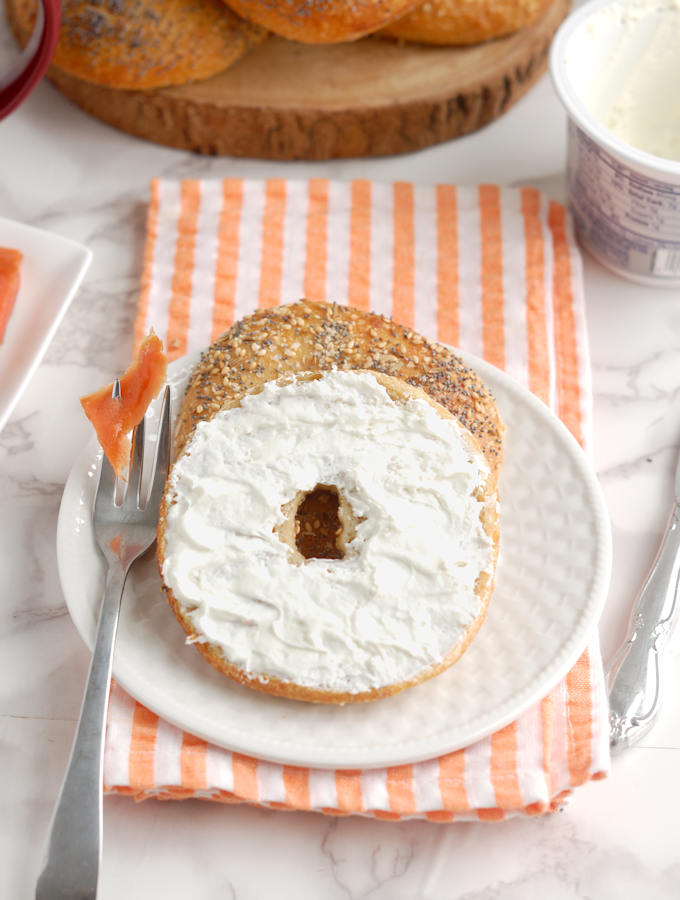
I know you hate to throw away that sourdough discard. Check out these recipes that use sourdough discard.
If you love this recipe as much as I do, please consider giving it a 5-star review.
Sourdough Bagel Recipe
Video
Ingredients
- 8 oz active sourdough starter (1 cup (100% hydration))
- 12 oz warm water (1 ½ cups)
- 22 ½ oz bread flour (4 ½ cups, divided, see note)
- 1 ½ oz barley malt syrup (2 tablespoons (or honey + molasses))
- 1 tablespoon table salt
- 2 oz granulated sugar (¼ cup (for boiling))
- 2 teaspoons baking soda (for boiling)
- corn meal (for pan prep)
- 1 egg white (whisked lightly)
- Topping (sesame seeds, poppy seeds, caraway seeds or coarse salt)
Instructions
- Combine 8 oz active sourdough starter, 12 oz warm water and 2 cups (10 oz) of the flour in a mixing bowl. Mix to form a thick batter. Cover the bowl and set aside for 30-60 minutes.
- Add 1 ½ oz barley malt syrup and 1 tablespoon table salt. Switch to the dough hook. Add the remaining 2 ½ cups (12 ½ oz) flour and mix to combine. The dough should eventually cling to the hook and start to clear the sides of the bowl.
- Knead 5 minutes on medium speed. If working by hand, stir in as much of the flour as you can, then turn the dough out onto a lightly floured surface and knead in the remaining flour. Knead 5 minutes. Form the dough into a smooth ball.
- Put the dough into a lightly oiled bowl, turning once to coat the dough. Cover the bowl and set it aside at room temperature. After 30 minutes uncover the bowl, lift one side of the dough and fold it into the middle of the dough. Repeat with the other three sides of the dough then flip the dough over. You're basically turning the dough inside-out to redistribute the yeast. Cover the bowl and repeat the procedure every 60 minutes for a total fermentation time of about 3 hours. The dough should be lively, elastic and airy. If the dough is still sluggish give it another hour or two at room temperature.
- Line a baking pan with parchment paper then generously sprinkle the paper with cornmeal (or flour). Turn the dough out onto a lightly floured surface without kneading out the air. Divide the dough into 10 even pieces. Use a cupped hand to roll each piece into a smooth, tight ball.
- To form a bagel, poke your finger all the way through the center of a ball to make a hole. Use two fingers to gently open up the hole. Continue gently stretching to form the bagel or twirl the dough around your fingers to widen the center hole to 1 – 1½" wide.
- Place the bagel on the prepared sheet pan and continue to form the remaining bagels. The dough will probably spring back a bit so you can go back and re-stretch the holes once you're done forming all the bagels. Cover the pan with plastic wrap. If the dough and the ambient temperature is on the cooler side, leave the shaped bagels at room temperature for 30 minutes then place the pan in the refrigerator overnight. If the dough and ambient temp is warmer and the dough is quite active, place the bagels into the refrigerator without leaving them out for 30 minutes.
- In the morning take the bagels out of the refrigerator and bring them to room temperature.
- Preheat the oven to 450 °F. In a large pot combine 1 gallon of water with 2 oz granulated sugar and 2 teaspoons baking soda and bring it to a boil. Reduce the heat to keep the water at a rolling simmer. Set a cooling rack over a sheet pan or kitchen towel and place it next to the stove. Line two half-sheet pans with parchment paper or silicone baking mats and generously sprinkle with corn meal.
- Once the oven is preheated, you're ready to boil. Gently lift a bagel off the sheet pan and lower it into the water, bottom side down. Depending on the size of your pot, you can boil 3-4 bagels at a time. Boil the bagels for 30 seconds then flip them. Boil the other side for 30 seconds. Repeat the process again for a total of 2 minutes boiling time. Remove the boiled bagels from the water and set them on the cooling rack to drain.
- Place 5 of the boiled bagels on each sheet pan. You could fit them all on one pan but they may stick together as they bake.
- Brush the bagels with egg white. Add the topping(s) of your choice. To make "everything" bagels combine a tablespoon of each of sesame seeds, poppy seeds & salt with a 1/8 teaspoon garlic powder and onion powder. Bake until golden brown, about 20 minutes.
Would you like to save this recipe?
As an Amazon Associate and member of other affiliate programs, I earn from qualifying purchases.









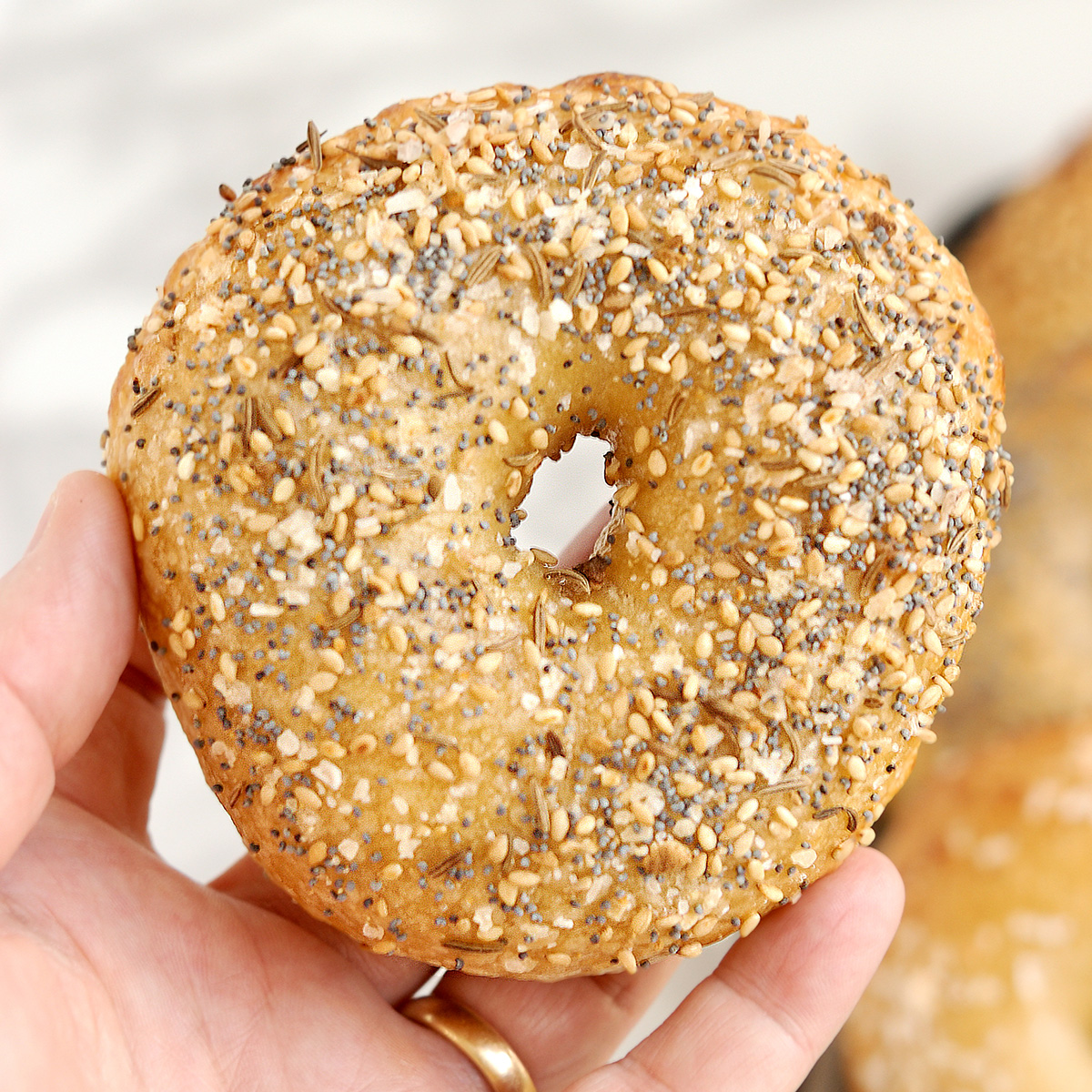
Your recipe is trash. The dough is too wet, your temp is too high and you’re clearly a moron.
You wasted my time and starter by acting like you know how to make sourdough bagels.
Wow! I know I should just roll my eyes and delete such a rude and personally offensive comment. But I do want to tell you that I make these bagels almost every week and they turn out beautifully every time. Apparently, I do know how to make sourdough bagels.
Eye roll indeed! So sorry people think it’s okay to speak to/about you like that. Knuckle-draggers…
Exactly, so sorry that people think it’s okay to just trash others with their words. I tried this recipe last weekend (baked Saturday morning for breakfast),my teenage sons enjoyed it. There were two left over, warmed them in the toaster and had on Monday. they were soft and tasted as good as freshly baked! I have tried quite a few of your recipes and have thoroughly enjoyed the outcomes. Thanks for all the efforts you put in to share your talents with amateur bakers like me.
I have made these bagels about 10 times and they have come out delicious every time. But that’s not really the point here–how sad must your life be if your default mode is to aggressively and rudely blame other people every time you make a mistake? You could have come here and done some troubleshooting with a helpful and generous blogger and left with a delectable bagel recipe to enjoy for years, but instead you just come here immediately spouting insults and vitriol. What a waste.
Hey Mark, it’s not Eileen’s fault you’re unable to read instructions, mine turned out great.
Hi Eileen. I am new to your site. I dehydrated some starter according to your instructions, and then decided I needed to test it out prior to sending the result to my sister. So, rehydrated according to your instructions. It took a bit longer than expected, but it is cold here these days. It came up really nice, I am pleased with that! So I made the bagels. The dough was beautiful to work with and it was a fun project. I do find them to be a bit flat and somewhat dense. Do you think I should have had them out of the fridge for longer than 30 minutes prior to boiling? I have also made the basic sourdough bread which turned out very well, and the pumpkin cranberry loaf with discard which was maybe a bit undercooked. My bad! I look forward to trying other recipes. Thank you. One thing I would like to see, is all measurements offered in grams as well as imperial. ie: both wet and dry ingredients. I like to weigh everything in Grams and was finding myself stumbling a bit with the math!
I do offer all the measurements in grams, except for the liquid measurements which I give in ml. I tend to measure my liquid ingredients in a measuring cup so that’s why I use ml instead of grams for liquid ingredients. As for the bagels, sourdough is so much fun because it does require us to use the recipe as a guide, but also adapt as the dough requires. I make the bagels quite often and will sometimes change the timing based on the temp in my kitchen. In the summer I put the bagels right into the fridge after shaping them and the next day they’re ready to boil by the time the water heats up. In cooler weather I always leave the bagels out for 30 minutes after shaping them, and then they go into the fridge for the night. If your bagels seem sluggish in the morning you can give them extra time before boiling. Just be careful not to wait too long because a very aerated dough can deflate when you pick up the bagels to transfer them to the water.
If they have measurements in ml you can convert use gram measurements. 1 ml = 1 gram, one of the many nice things about the metric system. For instance a liter (1000 ml) of water weighs a kilogram (1000 grams) or about 2.2 lbs. Hope that helps!
Hello. Thank you for sharing your recipes. I’ve tried this once already (good taste but flat), and in middle of trying again. Two things coming up: as others have pointed out, the gram measurement does not correspond to the cup measurement, and trying to figure out the 2.5 cups for the sponge doesn’t compute (puts the gram measurement WAY too high). I thought I’d check out the video to get a sense of hoe thick your “thick batter” is before letting the sponge rest (and measure by feel instead of grams), but cant find the video! (there are several commercial videos, and a video for other recipes — Caramel and fruit brandy something — but not the bagels…
A cup of bread flour weighs 5 oz. The conversion from oz to grams is 28.3g per ounce. The recipe calls for a total of 4.5 cups of bread flour, which weighs 22.5 oz. 22.5×28.3=636.75 grams. I rounded to 635g. I don’t know which 2.5 cups of flour you are referencing. The starter is mixed with the water and 2 cups of the flour to start. The video for the bagel recipe is the first video to run after an initial ad. After the bagel video is run, other recipes will run. If you re-load the page the bagel video will run again.
Thanks for responding! Sorry for confusion (I dont know where I got the 2.5 cups, either!). It is the one cup starter and 4.5 cup flour that dont compute in grams: 224g of 100% starter is 112g of flour (on the low side of cup-to-gram conversion for AP or bread flour), and 4.5 cups as 635g is 141g per cup (about average for AP or bread flour conversions). So I’m wondering if maybe the lower weight of starter, or higher percentage of flour is what is making these come out flat each time (still very tasty though!).
Sorry for the delayed response. I don’t always get notified of subsequent comments. I understand the confusion for the weight of the flour in the starter. I offer the volume for the starter for those who cannot weigh their ingredients, but it isn’t a perfect conversion since the weight of a cup of starter is approximate and can change based on how the cup is filled and how airy the starter is. This is why weighing ingredients for baking is always more accurate. By weight, the 4 oz of flour in the starter is 112g. I’m not sure what your question is about the 4.5 cups of flour. That conversion is correct as referenced in my previous comment. I would guess your flat bagels are due more to underdeveloped gluten or loss of air during transfer from the tray to the boiling water.
These are SO good and came out SO well that I’m nearly crying!!
Seriously, I just happened to find this website and I’m so glad I did!! Bagels, I feel, are the holy grail of sourdough baking (pun intended). I followed this recipe very closely and it did not disappoint!! I agree about having a strong starter. Mine was very sluggish coming out of the fridge, so I waited another day so I could squeeze in another feeding. I used it when it had tripled in volume.
THANK YOU!!
Also, do you think I can use dry malt powder in the water instead of barley malt syrup?